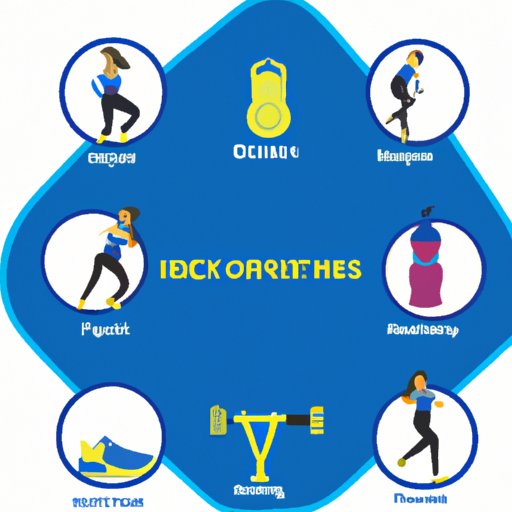Introduction
Metabolism is the process by which your body converts food into energy. It is a complex system that affects many aspects of your health, including your weight. Exercise has long been known to have a positive effect on metabolism and weight loss. This article will explore how exercise affects metabolism and weight loss, and provide tips for maximizing its effects.
High Intensity Interval Training (HIIT) – How it Boosts Metabolism and Encourages Weight Loss
High intensity interval training (HIIT) is a form of exercise that involves short bursts of intense activity followed by periods of rest or low-intensity activity. It is designed to improve both aerobic and anaerobic fitness. Studies have shown that HIIT can increase your metabolic rate, resulting in more calories burned during and after exercise. In addition, HIIT can help you lose weight by increasing fat burning and improving insulin sensitivity. Here are some tips for implementing HIIT:
- Start slowly. Don’t dive into HIIT if you’re not used to exercising regularly. Start with shorter intervals and slowly work up to longer ones.
- Choose exercises that you enjoy. HIIT can be done with any type of exercise, so find something that you like doing.
- Be consistent. To get the most out of HIIT, try to do it at least three times a week.

The Benefits of Strength Training on Metabolism and Weight Loss
Strength training is any exercise that involves using resistance to build muscle. It can include activities such as lifting weights, using resistance bands, or using your own body weight. Research has shown that strength training can boost your metabolism and help you burn more calories throughout the day. In addition, it can help you lose weight by increasing lean muscle mass, which helps your body burn more calories even when you’re not exercising. Here are some tips for incorporating strength training into your routine:
- Choose exercises that target multiple muscles. This will ensure that you get the most out of your workout.
- Pay attention to form. Poor form can lead to injuries, so make sure you’re doing the exercises correctly.
- Vary your routine. Try different exercises and switch up your workouts to keep your body guessing.
The Role of Cardio in Increasing Metabolism and Aiding Weight Loss
Cardio is any form of exercise that raises your heart rate and increases your breathing rate. Examples of cardio include running, swimming, biking, and walking. Cardio can help you lose weight by burning calories and increasing your metabolic rate. It can also help you maintain a healthy weight by improving your body’s ability to burn fat. Here are some tips for adding cardio to your routine:
- Start slowly. If you’re new to cardio, start with shorter sessions and gradually work up to longer ones.
- Find activities that you enjoy. Cardio can be done with any type of exercise, so find something that you like doing.
- Be consistent. Aim to do cardio at least three times a week for maximum benefits.

Eating Habits and Exercise – How They Impact Metabolism and Weight Loss
Your diet and exercise habits play a key role in regulating your metabolism and helping you achieve your weight loss goals. Eating healthy foods and exercising regularly can help boost your metabolism and encourage weight loss. On the other hand, unhealthy eating habits and a lack of exercise can slow down your metabolism and make it more difficult to lose weight. Here are some tips for improving your eating habits and exercise routines:
- Eat a balanced diet. Focus on eating whole, unprocessed foods and limiting refined carbohydrates and added sugars.
- Exercise regularly. Aim for at least 30 minutes of physical activity a day.
- Get enough sleep. Sleep plays an important role in regulating your metabolism and maintaining a healthy weight.
Exploring the Relationship Between Exercise, Metabolism and Weight Loss
Exercise has long been known to have a positive effect on metabolism and weight loss. Regular physical activity can boost your metabolic rate, which means your body will be better able to burn calories and fat. In addition, exercise can help you lose weight by increasing lean muscle mass and improving insulin sensitivity. Here are some tips for maximizing the benefits of exercise:
- Mix up your routine. Try different types of exercises to keep your body challenged.
- Set realistic goals. Aim for small, achievable goals that you can build on over time.
- Be consistent. Regular exercise is key to seeing results, so make sure you stick to your routine.
Conclusion
In conclusion, exercise can have a positive effect on metabolism and weight loss. High intensity interval training (HIIT), strength training, and cardio can all boost your metabolic rate and help you lose weight. Eating healthy foods and exercising regularly can also help regulate your metabolism and aid in weight loss. Finally, setting realistic goals and being consistent with your exercise routine can help maximize the benefits of exercise.
Exercise can have a powerful impact on your metabolism and weight loss. By incorporating HIIT, strength training, and cardio into your routine and improving your eating habits, you can maximize the effects of exercise and reach your weight loss goals.


